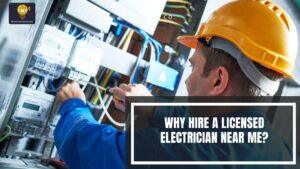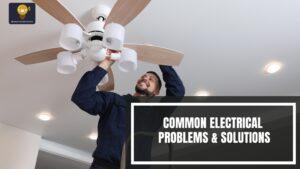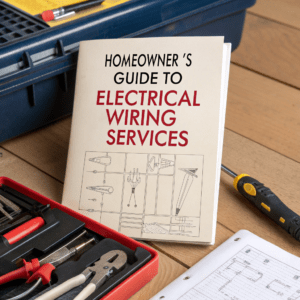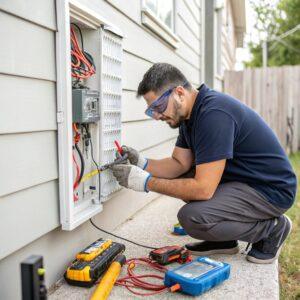What Every Home and Business Owner Should Know About Electrical Installation
Struggling with outdated wiring or unsure how to safely power your new space? Poor electrical setups can lead to costly repairs, power failures, or even dangerous fire hazards. Imagine a sudden outage in your business due to a faulty panel or a short circuit at home caused by improper wiring. These issues disrupt your life and risk your safety and property.
A safe, well-structured electrical installation is the backbone of any modern home or business. From lighting to security systems, everything depends on a reliable energy flow. Whether upgrading an old house or wiring a new building, this guide breaks down everything you need to know—from electrical panel installation to house wiring—so you can make smart, secure decisions.
Why Proper Electrical Installation Matters
A reliable electrical system is more than a luxury—it’s necessary. Proper installation ensures:
Safety Considerations
- Reduces fire hazards
- Prevents short circuits
- Ensures code compliance
- Protects appliances from power surges
Energy Efficiency and Cost Savings
- Reduces energy waste
- Lower utility bills
- Extends the lifespan of electronics and systems
When your electric installation is done right, you’re investing in long-term savings and peace of mind.
Types of Electrical Installations
Residential Electrical Installation
Homes require tailored electrical systems. Installations often include main panels, subpanels, dedicated circuits for appliances, and GFCI outlets in moisture-prone areas. Electrical installation house wiring must be carefully planned to accommodate future technology needs, such as EV chargers or solar systems.
Commercial Electrical Installation
Businesses often demand higher load capacities and complex circuitry. Commercial installations may include three-phase wiring, backup generators, and structured cabling for data. These systems must comply with stricter regulations to ensure safety and uninterrupted operations.
Outdoor Electrical Installation
Outdoor systems cover lighting, security cameras, outlets, and even weather-resistant fixtures. Outdoor electrical installation requires special materials like waterproof boxes and conduit to withstand the elements, making it ideal for patios, gardens, and signage.
Key Components of an Electrical Installation
Electrical Panels and Circuit Breakers
The electrical panel is the control hub of your home or business. It distributes electricity to various circuits and protects against overloads. Circuit breakers are safety devices that automatically cut power when irregularities are detected.
Electrical Installation Wiring Explained
Wiring carries electricity from the panel to devices throughout your building. It includes hot wires, neutral wires, and grounding wires. Understanding wire types and sizes is crucial, especially for high-demand areas like kitchens or server rooms.
Conduits, Outlets, and Fixtures
Conduits protect wiring from damage, while outlets and fixtures serve as user interfaces. Choosing quality materials and ensuring proper installation help maintain system integrity and functionality.
Electrical Panel Installation: What You Need to Know
Choosing the Right Panel
Panel size and amperage depend on your energy consumption. A 200-amp panel is typically sufficient for modern homes, while commercial spaces may need 400 amps or more. Future-proofing your panel allows for expansions without costly upgrades.
Installation Process and Safety Tips
Installing an electrical panel is a critical task that must be handled carefully. Here’s a quick breakdown of the process and safety precautions:
- Turn off all power at the main source to avoid shock or fire.
- Mount the electrical panel securely in the designated location.
- Connect all wiring according to the circuit design and electrical code.
- Test each circuit to ensure proper function and load distribution.
- Ensure proper grounding of the system for safety.
- Follow all local building codes and safety regulations.
Important: Always hire a licensed electrician to ensure compliance and reduce risks.
Understanding Electrical Installation House Wiring
Common House Wiring Layouts
Most homes use radial or ring circuits. Radial circuits are simpler, while ring circuits offer redundancy. For safety, bedrooms often have separate lighting and outlet circuits. Understanding your layout helps with troubleshooting and upgrades.
Best Practices for Homeowners
Keep wiring diagrams handy, label your breaker panel, and schedule routine inspections. Avoid overloading outlets and be cautious when drilling into walls. These habits enhance safety and system longevity.
Outdoor Electrical Installation Considerations
Weatherproofing and Safety
Use GFCI outlets and weatherproof covers in all outdoor setups. Conduits should be buried or securely fastened to protect them from physical damage. Always verify local regulations before starting any outdoor electric installation project.
Ideal Use Cases: Lighting, Security, and More
Outdoor electrical installation is perfect for accent lighting, surveillance systems, garden pumps, and entertainment zones. Smart outdoor setups can be controlled remotely, offering both convenience and security.
Hiring a Professional Electrical Installation Service
What to Look for in an Electrician
Choose a certified professional with experience in your type of project. Look for positive reviews, transparent pricing, and detailed project timelines. Ask about warranties and post-installation support.
Licensing and Insurance Requirements
Ensure your electrician is licensed and insured. This protects you from liability and guarantees the work meets industry standards. Ask to see credentials and verify them with your local licensing board if necessary.
DIY vs. Professional Electric Installation: Pros and Cons
| Factor | DIY Installation | Professional Service |
| Cost | Lower upfront | Higher upfront |
| Time | Longer | Faster |
| Safety | High risk | Code-compliant |
| Quality | Varies | Guaranteed |
| Tools Needed | Many | All provided |
In most cases, professional service wins in value and reliability.
Cost of Electrical Installation Services
Price Breakdown by Installation Type
- Residential installation: $1,500–$10,000, depending on size and complexity
- Commercial installation: $5,000–$50,000
- Outdoor installations: $500–$5,000
Factors include panel size, wiring complexity, permits, and labor costs.
Long-Term Savings Through Quality Work
High-quality installation reduces maintenance needs and energy usage. Over time, this leads to fewer repairs and lower utility bills, making it a smart investment.
Frequently Asked Questions
Q1: What is included in an electrical installation service?
It includes wiring, panels, outlets, lighting, and safety inspections tailored to the property’s needs.
Q2: How long does a home electrical installation take?
Typically, it takes 3–7 days, depending on size and complexity.
Q3: Is outdoor electrical installation safe in rainy climates?
Yes, with proper weatherproofing and GFCI protection, outdoor systems remain safe and reliable.
Q4: Can I install my electrical panel?
Only if you’re licensed. DIY panel installation without credentials is dangerous and illegal in many areas.
Q5: How often should I inspect my electrical system?
Every 3–5 years, or sooner if you notice flickering lights, burning smells, or breaker trips.
Q6: What’s the difference between electric installation and wiring?
Electric installation refers to the full setup, while wiring is just one part.
Conclusion
Proper electrical installation is crucial for any property’s safety, efficiency, and functionality. Whether outfitting a new home, upgrading a business, or enhancing your outdoor space, quality artistry pays off. Always prioritize safety, code compliance, and professional service to ensure lasting results.
Ready to power your property safely and efficiently? Contact NT Electrician today for expert electrical installation services you can trust!






